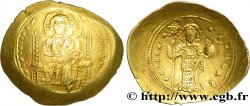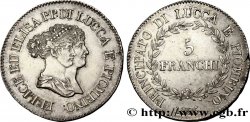v21_2268 - DOMITIUS CALVINUS Denier
MONNAIES 21 (2004)
Startpreis : 550.00 €
Schätzung : 1 000.00 €
unverkauftes Los
Startpreis : 550.00 €
Schätzung : 1 000.00 €
unverkauftes Los
Type : Denier
Datum: 39 AC
Name der Münzstätte / Stadt : Espagne, Osca (Huesca)
Metall : Silber
Der Feingehalt beträgt : 950 ‰
Durchmesser : 19 mm
Stempelstellung : 6 h.
Gewicht : 3,81 g.
Seltenheitsgrad : R2
Kommentare zum Erhaltungszustand:
Très bel exemplaire bien centré pour ce type de monnayage avec un très beau portrait, légèrement stylisé. Usure importante, mais exemplaire parfaitement identifiable avec un très beau portrait. Joli revers complet. Une patine grise superficielle recouvre l’ensemble de la pièce
N° im Nachschlagewerk :
Vorderseite
Titulatur der Vorderseite OSCA.
Beschreibung Vorderseite Tête d'Hercule à droite avec un collier (tête celtibérienne).
Übersetzung der Vorderseite “Osca”, (Huesca).
Rückseite
Titulatur der Rückseite DOM. COS. ITER. IMP.
Beschreibung Rückseite Instruments pontificaux : simpulum, aspersoir, hache à sacrifice et chapeau de flamine.
Übersetzung der Rückseite "Domitius Consul Iterum Imperator" (Domitius consul pour la seconde fois, Imperator).
Kommentare
Pour ce type, M. Crawford a relevé une estimation inférieure à trente coins de droit et inférieure à trente-trois coins de revers. Ce denier est en fait beaucoup plus rare que ne le laissent penser les différents ouvrages de référence. M. Crawford ne signale que deux exemplaires provenant des trésors de Maillé (1 ex.) et de Gallignano (1 ex.). Ce denier est souvent assimilé aux deniers espagnols.
For this type, Mr. Crawford noted an estimate of less than thirty obverse dies and less than thirty-three reverse dies. This denarius is in fact much rarer than the various reference works suggest. Mr. Crawford only reports two examples from the hoards of Maillé (1 ex.) and Gallignano (1 ex.). This denarius is often assimilated to the Spanish denarii
For this type, Mr. Crawford noted an estimate of less than thirty obverse dies and less than thirty-three reverse dies. This denarius is in fact much rarer than the various reference works suggest. Mr. Crawford only reports two examples from the hoards of Maillé (1 ex.) and Gallignano (1 ex.). This denarius is often assimilated to the Spanish denarii








 Berichten über einen Fehler
Berichten über einen Fehler Die Seite drucken
Die Seite drucken Teilen meiner Auswahl
Teilen meiner Auswahl Stellen Sie eine Frage
Stellen Sie eine Frage Einlieferung/Verkauf
Einlieferung/Verkauf










